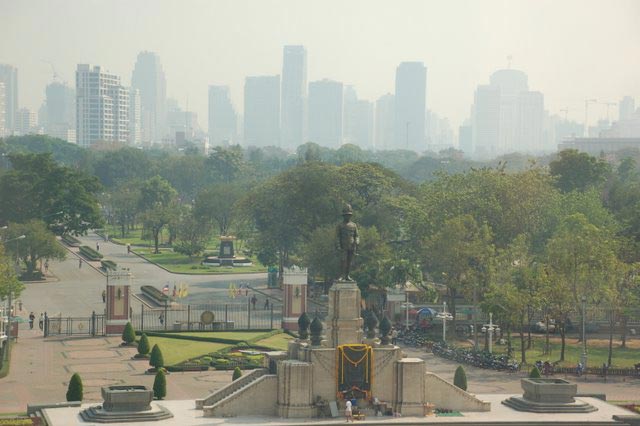In Industrial Thailand, Health and Business Collide
By Thomas Fuller | Dec 19, 2009

MAP TA PHUT, Thailand — Villagers here avoid walking in the rain because they say it burns their skin and causes their hair to fall out. They have trouble breathing at night when, they say, factories release toxic fumes. And they are terrified by what studies show are unusually high cancer rates.
Map Ta Phut is the heart of Thailand’s industrial underbelly, an area rarely seen by the millions of tourists who visit the country every year. Jutting out into the Gulf of Thailand, the industrial zone is on the scale of a midsize city — only instead of office buildings and apartments, there is block after block of tangled tubes of steel, vats of chemicals and towering, fire-breathing gas flares.
Two years ago, a group of residents decided to take their health grievances to the courts, a relatively rare move in Thailand, where street demonstrations are the preferred form of civil action. The lawsuit, filed by 27 villagers, has become a landmark in Thailand’s environmental movement, leading to a cascade of decisions that halted a staggering $9 billion worth of industrial projects, including Japanese steel factories and German-owned chemical plants.
The judgments stunned foreign investors, infuriated powerful Thai companies and jolted an already shaky Thai government. The Thai Chamber of Commerce has warned that if the injunction against dozens of projects is not lifted soon, the entire Thai economy could suffer for the next decade.
But from the perspective of Srisuwan Janya, the lawyer who won the case, the injunction signaled a new dawn in the country’s development and the end of an era in which Thailand’s paramount objective was bolstering gross domestic product.
“From now on industries will not only care about making money,” said Mr. Srisuwan, who comes from a family of rice farmers. “They have to care about the environment and the well-being of the people in the community.”
Even among critics of the court decisions, there is widespread agreement that Map Ta Phut is heavily polluted and unhealthy for those who live nearby. But environmental experts remain skeptical that the court decisions will fix the problem.
The injunction stopped new projects, but older, more polluting facilities were allowed to carry on. The rulings require the government to write a new set of environmental laws. But what Thailand needs, experts say, is not new laws but better enforcement of existing ones.
“In rural areas, there is almost no enforcement at all,” said Anthony Zola, an American environmental consultant. “Water pollution, air pollution, noise pollution — you can make all the complaints you want and no one pays any attention to you.”
Reports detailing how unhealthy this area is for those who live and work in the shadow of the refineries, plastics factories and other petrochemical facilities here have stacked up over the years.
Thailand’s National Cancer Institute found in 2003 that rates of cervical, bladder, breast, liver, nasal, stomach, throat and blood cancers were highest in Rayong Province, where Map Ta Phut and other industrial zones are located.
A study released in 2007 found that people living near Map Ta Phut had 65 percent higher levels of genetic damage to blood cells than people in the same province who lived in rural areas. Such cell damage, which is a possible precursor to cancer, was 120 percent higher for refinery workers than in residents of rural communities.
Marco Peluso, the lead author of the study, said similar levels of genetic damage might occur in some places in Eastern Europe or developing Asia, but it that would be rare to see these levels in the West.
The main problem appears to be air pollution. The Thai pollution control department reported in September that it had found nine types of carcinogenic compounds in the air around Map Ta Phut.
In March, an initial court decision from the lawsuit by the 27 villagers declared Map Ta Phut a “pollution control zone,” obliging the authorities to measure soil and water quality regularly and to come up with a plan to reduce pollution if it is too high.
Read more on a Page 2












